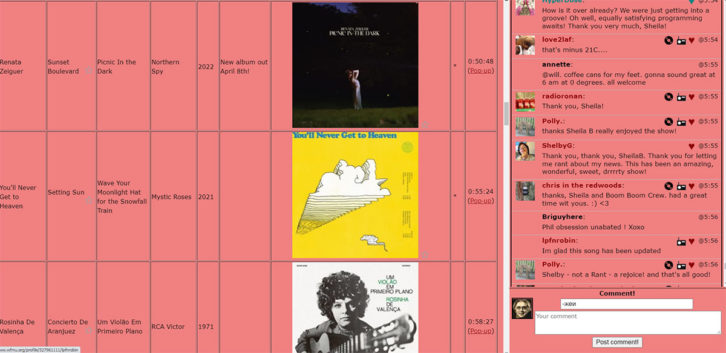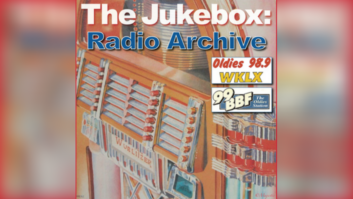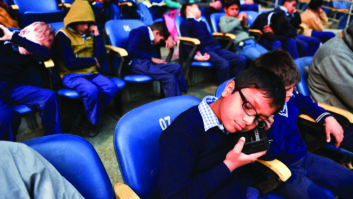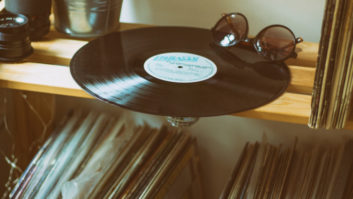Radio World’s “Guest Commentaries” section provides a platform for industry thought leaders and other readers to share their perspective on radio news, technological trends and more. If you’d like to contribute a commentary, or reply to an already published piece, send a submission to [email protected].
The author of this story is the general manager at WFMU. This is part of a series by the NFCB, whose commentaries appear regularly on Radio World.
A few years ago I had just finished my three hour music show on WFMU when a listener email arrived in my inbox. “Great show Ken! You should post all the music to a Spotify playlist!”
Thanks for the helpful hint, I thought to myself. I just did a three hour music show, and maintained a real-time, illustrated, interactive playlist as I did it. My station apps and website all showed every song as I played it — individually as well as in context of the entire show. Why would I want to devote the time to create a second, lesser copy of the exact same thing? While I pondered this question, that same listener was already hard at work creating exactly what he had suggested, a Spotify playlist of my entire show, minus all my annoying, aimless DJ blather.
What I didn’t understand at the time was that, for many listeners under the age of 50, playlists are the new radio. These listeners use playlists to share their favorites with each other, and to discover new songs and artists. Online playlists are the current incarnation of the mixtapes of old, but with the community-building capabilities of social media.
Yet, most radio stations, if they offer playlists at all, have not risen to the challenge of offering the types of playlists that younger listeners have come to expect. “Hyperpop,” a recent buzzworthy electronic genre, gained prominence and record industry attention not through radio airplay but through these online playlists.
The problem here might be that the word “playlist” has deep roots in the radio industry.
Radio, of course, has used the word “playlist” for many decades, but its meaning was and remains practically the opposite of what the word means to the youth of today. Radio playlists usually meant relatively small lists of songs which are pre-approved for airplay by market researchers or program directors. Conversely, today’s generation of playlist users are absolutely unrestricted, and they use that freedom to make friends, enjoy old music and discover the new.
The different meanings of the word can create a clash of cultures.
A few weeks ago, I was listening to a demo tape from a prospective, new DJ. After the first song ended, the mix went to complete silence. I made a note to mention this issue to them. But after the second song, I heard another gap of dead air, and so on for the entire 90 minute demo. I realized that what I was listening to was not a radio show per se, but a Spotify playlist absent a crossfade feature, with occasional breaks for the DJ’s scintillating personality. But there were no crossfades, no ramps, no mixing whatsoever. When I spoke to my prospective host, I complimented their musical choices but I had to offer a remedial course on what radio is and was. This person had been raised on playlists, not on radio, so my description of the craft was a new revelation for them.
[Read More Guest Commentaries Here]
At WFMU, we began adding online playlists to our digital offerings in 1999, simply to answer in real-time the most common question we received from listeners: “what was the name of that song?” Over the years, we’ve continued adding to our playlist feature, making them illustrated with album covers or other art. Plus, hyperlinks to the bands’ personal pages. Today we have more than 20,000 listeners with registered accounts which allow them to comment on, or otherwise enrich, our real-time playlists anonymously. You can see it in action 24/7 at wfmu.org, if you click on “playlist & comments,” or via the WFMU apps.

Perhaps the biggest challenge we’ve faced with this approach has been the moderation which is needed to prevent bad online behavior, and to keep the playlist/chat community a positive, helpful place… you know, instead of a cesspool, like chats and comments in most other forms of social media. It’s been a lot of work and coding and experimenting, but it’s been well worth it. Many of our youngest listeners and donors are attracted to WFMU initially not because of our radio programming, but because of our online playlist chat community.
But the people who hang out on our playlists and chat all day are not representative of the typical radio listener. These people are a subset of our P1 listeners, a focus group, a peanut gallery, a fan community, depending on which of our DJs you discuss it with. The playlist and the chat may not represent the totality of our radio audience, or the full craft of radio, but it provides radio with the real-time community and interaction that younger listeners now demand.












